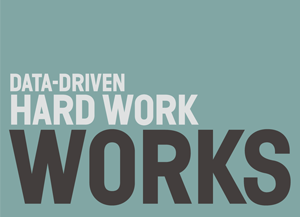The AMT Lab researchers and editorial staff are proud to announce the release of the 2015 Ticketing Software Survey. After 3 surveys across 6 years, the research team is happy to announce that ticketing software systems are meeting most of the needs faced by arts institutions. Yet there are significant differences in feature use and perceived importance when analyzed across budget size, geographic area or discipline. In addition to deep analysis of the data, the report includes an appendix of every question and the raw data. Vendors and institutions will find this report useful for future decision-making and grant writing.
Idealware's Infographics for Outreach, Advocacy, and Marketing Webinar
Contributors Aoni Wang and Giorgia Gandolfini recently attended Idealware’s webinar, Infographics for Outreach, Advocacy, and Marketing: From Data to Design . This talk delved deeply into strategies for successful design of infographics.
Per Idealware, an infographic is an image that presents data, transferring numbers into a comprehensive visual narrative. Infographics have become very popular among organizations, as they are generally easier to understand and more effective at communicating data to the population at-large than traditional spreadsheets and reports. Infographics attract attention and provide new ways for visitors to engage with data.
Data That Matters: Three More Metrics to Grow Audiences and Revenue
This article is cross-posted on the blog Analysis from TRG Arts.
Read the first post in this two-post series here.
Last month, I wrote about the overwhelming amount of data produced by the sophisticated database systems now common in the arts industry. My commentary on the “analysis paralysis” that can result caught the attention of many of our readers. We’re glad, because 20 years of consulting work has taught us this: data-driven hard work works.
Data That Matters: Three Metrics to Grow Audience Relationships
This article is cross-posted on the blog Analysis from TRG Arts.
With the arts and cultural annual conference season in full swing, we’re thrilled to see the priority that integrated patron loyalty now has in field dialogue. Prioritizing patronage can have a real impact—on year-over-year revenues, the volume of people attending and visiting arts and cultural organizations, organizational relevance, and more.
Top 10 from the Nonprofit Technology Conference (NTC) 2014
Data-Driven Decisions for Arts Marketers
AMTLab contributor Christine Sajewski discusses strategic uses of internal arts marketing data, as illustrated through a hypothetical performing arts organization, the Ugly Duckling Ballet. Read the full report here.
Opera America: Celebrating 13 Companies’ Strategies for Audience Development
This week, Opera America announced the thirteen opera companies selected to share $300,000 in grants to support programs and projects that increase first-time opera attendance and return visits. The individual grants range from $7,500 to $30,000. The thirteen companies (and their projects) are:
Gamification in the Arts part 4: Gamification for Marketing
In past articles we tackled analysis of gamification as a tool for arts organizations as well as some methodology about how to design a game or game elements. This post will relate to how gamification can be used as a tool for marketing efforts. Gamification can be message, channel, and even marketing education. A game can be a marketing channel of its own for your organization or it can reside within a number of other channels.
Gamification in the Arts, Part 3: Game Design
Game design is, unfortunately, something that not many people are skilled at. The chances of being able to find and hire an experienced game designer in your area is slim. This leaves two options: consultants, or the process of educated trial and error. The iterative process: create a game, try it out, go back to the drawing board and improve it, try again. Almost anyone can ultimately find success in designing a game layer for use with a marketing, development, or educational effort
Want to succeed in social media marketing? Work with influencers!
Are you the one who used to think the number of fans reflects the effectiveness of a social media campaign? According to a recent Technocrati study, Facebook likes ranked as the most important metric when evaluating a social marketing campaign. However, this changes when people are getting more sophisticated about using social media—they do not take seriously the “like” button anymore. Now, we need to realize that social influencers, who can spread a brand’s message effectively, considerably determine the success of a social media campaign.
Gamification in the Arts, Part 2: What games fit what demographics?
"Video games sit at the confluence of history, technology, and art in such a way that's found in no other medium a place where influences from every creative field meet, mix, and recombine." -Daniel D. Snyder, The Atlantic. When most people conjure the image of a gamer they generally think of the past: a nerdy 18-25 year old male, probably white. The face of gaming has changed significantly over the last twelve years and now both men and women, young and old, and people of all races are engaged in games on a regular basis. Simply put, almost every conceivable group of people is now engaged in gaming, just not all groups are engaged in all types of gaming.
According to a report put out in 2012 by the Entertainment Software Association, the average American households have at least one dedicated gaming consul, PC, or smartphone and 49% of US households have an average of two. Roughly a third of game players in the US are over the age of 36, one third are between the ages of 19 and 35, and the remaining third are 18 and under (meaning that two thirds of gamers in the US are adults and that the average age of a game player in the US is 30!) Also, gender wise game players are now split evenly with 47% of all electronic gamers being women.
"What we are seeing in games is art at a world class stage design that is almost unmatched anywhere else. It has been very exciting to me to see so many ideas that integrate social good and efforts to make the world a better place through games." -Al Gore, former Vice President of the United States
The way in which people are engaging with games is changing. Console gaming (Microsoft X-Box, Sony Playstation, and Nintendo Wii) has been on the decline over the last couple of years while social media gaming and mobile device gaming has been on the increase. Similarly board gaming has also been on the rise (according to the 2011 US Census section on Arts, Recreation, and Travel) for the last twelve years with the explosion of number and quality of titles and has drawn increasing numbers of 'board game geeks' who wish to connect with people in person in the face of an increasingly electronic world.
So who plays games? What games do they play? Electronic gaming wise, women tend to skew towards games like The Sims (which is the "World's Biggest-Selling Simulation Series", and "Best Selling PC Game of All Time"), dance and fitness games, and social media gaming. Men tend towards first person shooters, strategy games, and sports games. Both men and women tend to engage in role playing games in roughly equal numbers. In the board gaming world less information is out there about consumption and engagement but it can be assumed, somewhat safely, that similar propensities exist throughout different platforms.
How can the arts harness this? As arts groups such as The Tate, The Royal Opera, Jacob's Pillow, and other groups explore game like content and applications they can use this data to fine target the apps they create towards market segments. As an industry, any arts group can use a game dynamic in order to drive deeper engagement in marketing or development. Activities such as the Glass Hunt on the Oregon Coast have proven successful at driving interest in art through a game layer, in this case, a scavenger hunt. Other groups such as 2am theatre have used applications such as scavengr to drive similar efforts in a combined physical and electronic fashion. In the arts, a typical marketing campaign has a one way thrust: "buy tickets, come see our show". With games, can be enticed to have longer involvement time-frames and be induced to repeat engagement.
Has your organization explored the possibility of using a game dynamic? Was it through social media, an app, or through an old school scavenger hunt? What did you find successful? What were your challenges? This series will continue in two more weeks with an exploration of how to approach game design, test games, and implement them. If you have questions regarding this topic or any others please ask them in the comments section!
Now Boarding on Platform One: Madrid’s Library Lending Machine
Libro express (translation: Book express) is a new initiative and collaborative project between Madrid's libraries (las bibliotecas), the Community of Madrid (la Comunidad de Madrid), and Renfe (Spain’s state-owned train company). Libro express is the only library book lending machine of its kind in Spain and in Europe.
Gamification in the Arts, Part 1: Assessing your organization and patrons
In the next two months a multi-part series will be published on this blog outlining how to assess, develop, implement, refine, and measure gamification as a potential tool for your arts organization. This first round of tools will allow you to better discern whether your organization is ready for the project, and if patrons would engage with a game project.
To App or Not to App: That is the Question
Arts marketing and communications blogger Marc van Bree (aka Dutch Perspective) proposes that apps may not always be an ideal mobile option for arts organizations. Studies comparing web browsing and mobile apps are inconclusive regarding projected user popularity in coming years, leaving organizations with multiple possibilities for cultivating their mobile presence.
Technology Start-Up Links to Artists and EVERYBODY wins
Dr. Gang Lu, the Founder & Chief Editor of TechNode.com, and independent China Internet business observer, researcher, and open-concept evangelist, firmly believes the Internet environment is still young in China and it is beginning to change and evolve. Far from slowing down, the past two years have brought a new challenge of entrepreneurship to Lu and his team after launching Kuukie (pronounced “cookie”), a custom, digital card print house with a social media edge in 2010. After over four years as an “unprofessional, professional tech blogger” covering both Chinese Internet and tech industry news and analyses, Lu didn’t feel right offering up advice to entrepreneurs if he himself did not have start-up experience. With his background and passions, social marketing seemed the logical choice for him, but it was only the beginning.
The Importance of Operating a Social Media Campaign
While readers of Technology in the Arts are likely active participants in social media and early adopters of all technology, the following guest post provides additional fodder for those still convincing their organization's leaders that social media is a necessary step for the organization. Guest Correspondent: Eric Taylor
Eric Taylor is a business developer and a writer for the Facebook ad campaign tool Qwaya, which focuses on building tools for social media marketing. Qwaya provides information, tools and up-to-date news about Facebook marketing strategies. The site aims to build a sophisticated tool with powerful features that are user-friendly and affordable for online advertisers and marketers world wide.
Social Media Campaign Opportunities
Have you considered creating a Facebook page yet? If not, you may already be behind the 8-ball in terms of brand awareness. The majority of new businesses today are focusing intently on social media marketing, and practically every popular brand across the globe has some sort of online presence.
There is a lot to gain from starting a social media campaign. Sure, a business or organization might be able to achieve success without developing an online social presence, but with the lay of the land today, there is really no reason to risk it.
Unless you reside under a rock or live in an area with total Internet blackout, you already know just how prevalent social media is in today’s culture. To not develop a campaign and an online presence would simply be foolish in your part.
Why Marketing in Social Media is a Must-Do
Constructing Channels of Communication
No matter at which point in history a business rose to prominence, communication has always played a role in the success. With social media, the options of communication are vast. Especially for those working with visual products, social media has opened an entire new way of communicating.
Take Brooklyn Museum for instance. Via their Facebook page, art enthusiasts around the globe can follow the production of exhibitions, watch videos and follow peoples’ discussion about the museum. This “content” is not just great for the fans, but also serves as a marketing channel.
Facebook as a marketing channel can be honed to an extremely narrow scope, communicating specifically with those more likely to purchase from your business, or you can use your social channels to carry out broad communication to boost your brand’s presence. Or both.
Using social media sites enables you to easily open up multiple channels of communication.
Keeping Your Base Satisfied
Not everyone who sees your updates will become a customer, but you can make people interested in what you do by consistently delivering high-quality material at a frequent rate. This ensures that your visitors are more likely to become fans, and that fans are more likely to become customers.
By using social media to communicate with customers and to operate an open, honest campaign, you’re also turning customers into long-term repeat customers. Your brand becomes interactive, and instead of acting as just a logo or a name behind a product or service, you put an authentic face to the business. This creates satisfaction across the board.
High Return on Investment
There are a few reasons why operating a successful social media campaign will offer you a higher return on your investment. First and foremost, you have to understand that you’re not investing nearly as much. Keeping up a social presence doesn’t cost a lot. You’re mostly investing your staff time with no advertising dollars spent.
Then there’s the fact that social media engagement rates are through the roof in 2012, especially on Facebook and specifically with quality content created with the target audience in mind. Fans and customers see more personality in the material and thus they’re more likely to click-through, sign-up, purchase, and most importantly, they’re more inclined to keep returning.
But engagement is even more important for businesses that are not (only) in it to make money. While, many traditional corporations still see most revenue from TV, billboards, magazines and other unsocial advertising formats.
For organizations with a mission, social marketing can be their biggest advertising format. Let’s look at Brooklyn Museum again.
Brooklyn Museum’s social fan base:
- Facebook: 71,000 fans
- Twitter:386,000 followers
- Instagram: 36,000 followers
So if the Museum would like to communicate something, they will instantly reach hundreds of thousands – people who have chosen to follow the museum online. In other words, they’re not random people but the perfect target group for social advertising.
These social-media efforts certainly help the campaign of getting people to donate money, which is presented in a Youtube video and is the first thing you see when entering the website. Getting this reach and these results through traditional marketing would be too expensive for a lot of businesses and organizations, especially when the fan base has very specific interests and is scattered all over the world.
If you haven’t started a social media campaign yet, whatever type of business you’re operating, there’s no better time than now to get started. You might not take off and become the most popular brand out there, but a light yet strategic social presence is better than no social presence.
Data vs. Message: Which wins arts patrons?
What’s more important, what you say or who you say it to? Some might argue that a precisely defined target market can trump the creative message or offer. Proponents of the “killer offer” believe the right compelling message will overcome an imperfect effort to define the “who” in the equation.
I’m convinced that data, not guesswork or intuition, must drive sales and contributed revenues. A perfectly crafted message sent to the wrong prospect or patron is not only a waste of money, but damaging to the relationship we are trying to foster with our patrons.
So, message doesn’t matter? Wrong.
Data is incredibly important –and has arrived as the Secret Sauce of winning supporters. But data alone cannot drive success.
In his brilliant book, The Power of Habit, New York Times staff reporter Charles Duhigg explores how habits guide our lives as citizens and consumers – especially consumers of brand name products. Brands become habits that are very hard to break. If you live in a Tide or Crest toothpaste household, it is almost impossible to change the habit of buying those specific products.
Enter retailing giant, Target.
Like major retailers everywhere, Target collects terabytes of information about consumers and their purchases. Their desire to exploit moments of potential brand fickleness prompted Target management to look at changing purchase patterns as a predictor of specific significant consumer readiness to buy.
“Pregnant women and new parents are the holy grail of retailing,” a Target analyst told Mr. Duhigg in an interview for his book, which was excerpted in New York Times Magazine. They have much to buy and are relatively price insensitive. And, new brand habits can last for decades. Predicting pregnancy could be worth millions from a small group of customers.
From data, Target learned that pregnant women buy more vitamins and specific minerals, unscented lotions and soaps, hand sanitizers and a few dozen other products. Their data analysts actually built a model to predict a due date for the baby.
Data wins, right? No. As Mr. Duhigg reports, it turns out that “hiding what you know is sometimes as important as knowing it.” Sending a likely pregnant mother coupon offers for diapers or discounts on maternity clothing may be good direct marketing but likely will be seen as a creepy intrusion into a customer’s private life.
For Target, the solution became one of messaging – meaning that they could successfully make expectant baby offers so long as the offer appeared to be random or non-specific to the pregnant woman. Diapers and lawn mowers. Vitamins and DVD players. If the offer appeared to be directed to everyone on the street, she would respond. Target sales to likely pregnant moms soared.
During the recent presidential campaign, Obama volunteers made millions of outbound telephone calls with scripts that included questions asking voters to visualize their behavior on Election Day. “What time of day will you vote?” “Will you drive or walk to your polling place?” “Which route will you take?” Such visualization techniques markedly improved the probability of the voter’s carrying through with the desired action – in this case, casting their ballot on Election Day.
Considerable research is emerging around the use of offers that rely on social or peer recommendation to encourage a positive action. The rise of Facebook, Twitter and other social media channels offers limitless opportunities to build virtual communities around any idea. When coupled with expansive data resources, the effectiveness of social media and other tools for creating new patrons and deepening existing relationship grows exponentially.
But data does not create relationships. Data is just an inert tool that allows conversation, cultivation and the building of relationship to occur in a much more efficient way. And ultimately, patron values only rise when a sense of relationship exists between people: patrons, artists and the art that is being created. Passion is an indispensable part of the equation. Obama campaign architect, David Plouffe offers,
If you want to "…build a grassroots campaign, ... it's not going to happen because there's a list or because you have the best technology. That's not how this works. They have to build up that kind of emotional appeal so that people are willing to go out there ... and spend the time and their resources and provide their talents ... But the reason those people got involved was because they believed in Barack Obama. It was a relationship between them and our candidate."
This concept has deep roots. Four decades ago, Danny Newman counseled arts organizations to host house parties that brought together friends from the country club, bridge club and PTA. His goal was to use peer community networks to get neighbors to encourage neighbors to “Subscribe Now” – to support the local ballet or symphony orchestra. And it worked.
As humans, we crave community and relationship. Tools like Facebook and predictive modeling allow arts organizations to tap into the DNA of our patrons and their communities – and do so in a very efficient way. Ultimately message trumps everything.
What have you learned from using data to craft your message?
SEO Your Location on Mapping Programs
 Locations on maps are subject to the similar search engine optimization algorithms that websites are. Google, and other mapping programs take relevance, type of business, prevalence, tags and other metadata and other factors or order the representation of physical business on any map you call up. Simply claiming your address on Google, Yahoo, Mapquest and other portals is the first step. The algorithm that arranges addresses on any given maps search page takes into consideration over 100 different factors when delivering the results in the order they do. Some you don't have control over and some you do. Here are some suggestions for improving your address in search ranking on maps.
Locations on maps are subject to the similar search engine optimization algorithms that websites are. Google, and other mapping programs take relevance, type of business, prevalence, tags and other metadata and other factors or order the representation of physical business on any map you call up. Simply claiming your address on Google, Yahoo, Mapquest and other portals is the first step. The algorithm that arranges addresses on any given maps search page takes into consideration over 100 different factors when delivering the results in the order they do. Some you don't have control over and some you do. Here are some suggestions for improving your address in search ranking on maps.
- Citations: Linking the URL for the s page directly from other pages, preferably pages that Google and other search engines trust. The more trustworthy sources that list the business address the more the impact will be. Direct URL links to the map of the business should be available on all sites you control: your website, wikipedia page, and social media.
- Reviews: For instance a review of the business location on google will help with optimizing your google results, rinse and repeat for Yelp, etc. (example: if you plug "Georgetown Liquor Co, Seattle" into google maps, the business has 29 reviews). Reviews need to be linked directly to the address you want to be found. Caution: faking reviews can backfire. Most reviews a mixture of positive and negative, fake reviews are pretty obvious.
- User content: Check in on Foursquare, Facebook, Twitter, etc. Of course you need to claim the address listing for the map that the application uses.
In addition to these three things, standard usage of SEO best practices are applicable to mapping. Use names such as 'Map to XYZ Theater Company' rather than 'click here for a map' as your link. To quote a friend, Mark Gerth of the Washington State Arts Alliance (who first turned me on to SEO), 'click here' doesn't need help being found, you do.
If you have additional helpful suggestions for Geo SEO please leave them in the comments!
On Demand, In Vain?
By Katherine Schouten Rick Archbold recently published a piece in the Literary Review of Canada exploring the impact of self-publishing on the future of literature. The swift rise of print-on-demand technology (POD), which enables users to produce small print runs of titles through cost efficient means, has inaugurated a rush of unfettered works. Visual and textual, personal and professional, fictional and factual, literary and mundane, POD capabilities have empowered all those who possess the inclination to publish self-created goods.
As Archbold acknowledges, such access brings with it thorny issues, of which much conversation has been, and is being, had. (A thoughtful example from Christina Patterson can be found in The Independent.) But his argument brings the quandary around to the other side: what work that ought to be considered “literature” is being passed over precisely because it’s not from mainstream publishers? What might otherwise be considered “legitimate,” if not for the stamp of “vanity publishing” currently affixed by the industry to volumes precisely because they are printed by the very authors who wrote them? More urgently to Archbold, what works of literary art may society lose because self-publication is deemed vain?
Underscoring these conversations is the dualistic role the medium of a book, physical or electronic, plays, both as a vehicle for art (i.e., literature) and as a dynamic tool of communication. It remains one of our most fundamental technologies; how we access it, and whom we allow or enable to produce it, is rapidly changing. But could it be that with this technological evolution we might reinvigorate the book’s latter role, as a tool? If so, arts organizations—indeed, nonprofits of all varieties—stand to benefit. Books self-published using POD carry the potential to serve as an effective means of promotion and commemoration, a revenue stream in the form of merchandise, a powerful platform to aid applications for grant and foundation funding, and an enticing incentive for tiered giving. Most providers (Blurb, Lulu, etc.) are now compatible with Adobe InDesign, further aiding the integration process by enabling graphic designers to work in a preferred medium (rather than being limited to proprietary templates). They also now have ebook options, to deliver self-published goods to potential readers in their preferred format.
The conversations and concerns surrounding the implications of POD and self-publishing on the broader industry will no doubt continue. But the possibilities they hold for the nonprofit sector are palpable, vanity or not.
For a primer on self-publishing, see Alan Finder’s recent article in the New York Times, “The Joys and Hazards of Self-Publishing on the Web.”
Gaming or gamification: a tool for the arts
 According to surveys done by Comscore, gaming online, on smart phones, and among women has been growing for years. Likewise the number and quality of board games has exploded in the last twelve or so years. The upshot of these phenomena is a clear indication that gaming and gaming culture is on the rise globally and all indications are that slow and steady growth will continue to happen in this sector.
But how do the arts harness this phenomena? Game dynamics can be used to attract attention, deepen interaction, and retain interest. Games of course have always held interest in technology and examination of game mechanics regularly shows up on Tech literature. Beyond the tech world gamification has also become a subject of interest in the corporate world in general. Gaming and gamification holds promise for the arts. Applications include game dynamics on websites to bringing game mechanics to your marketing or development efforts.
According to surveys done by Comscore, gaming online, on smart phones, and among women has been growing for years. Likewise the number and quality of board games has exploded in the last twelve or so years. The upshot of these phenomena is a clear indication that gaming and gaming culture is on the rise globally and all indications are that slow and steady growth will continue to happen in this sector.
But how do the arts harness this phenomena? Game dynamics can be used to attract attention, deepen interaction, and retain interest. Games of course have always held interest in technology and examination of game mechanics regularly shows up on Tech literature. Beyond the tech world gamification has also become a subject of interest in the corporate world in general. Gaming and gamification holds promise for the arts. Applications include game dynamics on websites to bringing game mechanics to your marketing or development efforts.
Roughly speaking game mechanics fall into a number of broader categories and smaller subcategories of stimuli and response mechanisms:
- Achievement: points, levels, rewards, recognition, and gifts.
- Competition: leader boards, envy, varying challenge from human interaction, and the human competitive instinct.
- Cooperation: altruism, social fabric, communal discover, commerce, and teamwork.
- Ownership: building something that is yours, loyalty, self-expression, and loss avoidance.
Before embarking on gaming or gamification it is wise to consider your brand, your audience, and your goals. In order to motivate specific behaviors the right combination of mechanics and dynamics need to be in place and these can vary from audience to audience. Indeed, high powered consultants at high powered firms can be hired to help with gamification but this isn't always necessary. A simple, well planned addition of gamification can increase time spent on a website by two or three fold. For instance, if a customer answers three questions correctly about your organization's history they get a 5% discount on their current purchase. Will everyone participate? Probably not, but it will deepen the experience for a number of people and potentially deepen their understanding and commitment to your organization.






















